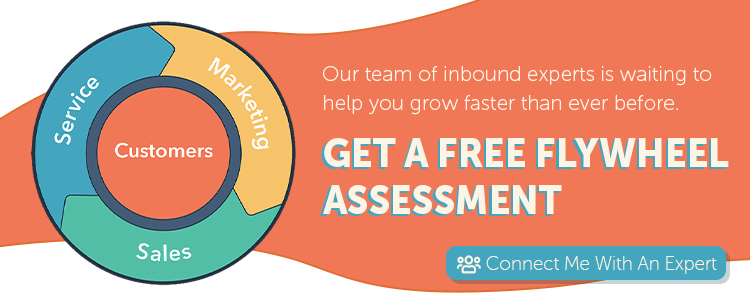Your flywheel business model is where you drive real business results in a sustainable way. Or it can be a big obstacle, especially if you’re not addressing your existing friction points.
Unfortunately, companies either aren’t aware of ongoing inefficiencies within their organization, or they just accept them. This apathy can cost your company millions in revenue. If you see your tire losing pressure while you're driving on the highway, wouldn’t you pull over and fix it?
The same goes for your flywheel business model. Be proactive in addressing issues early on so you can build and maintain momentum as your company scales.
I know this can feel intimidating. You might be thinking, “Who has the time for this?” The good thing is you can make big improvements that take less than 10 minutes.
Here are nine quick flywheel fixes:
Marketing
Your marketing should include automation tools. You can streamline plenty of processes to drive lead generation and feed your sales pipeline with high quality prospects.
Here is how you can make quick updates in your marketing machine.
1. Set Up Live Chat on Your Website.

Live chat really benefits all aspects of your flywheel, including sales and service. So this quick win is actually three quick wins rolled into one.
From a marketing perspective, live chat enables you to respond in a faster, more efficient way to boost engagement with visitors. Why? Because how quickly you respond to visitors makes or breaks your lead generation efforts.
Drift’s 2017 survey found that there’s a 10x decrease in the chances of making contact with a lead after the first five minutes. The response time from your marketing and sales team is so important to actually getting visitors into your sales cycle.
Setting up live chat takes just a few minutes. We walked through the live chat setup in HubSpot. It consists of these few steps:
- Connect a chat channel with your conversations inbox.
- Create a chat profile, which includes a representative’s photo, name, and meetings link.
- Then, create a live chat chatflow, where you select “Welcome Visitors” to trigger a prompt to send visitors directly to your live representative.
Within the chatflow, you simply customize the message content, specify which users receive the prompts from visitors, and set rules for assigning incoming conversations to your team.
With live chat in the works, your visitors can make direct contact with your team in a moment’s notice. Building this personalized, engaging user experience is a crucial piece of the marketing puzzle.
2. Add Analytics Tracking Code to Your Webpages.
You can’t optimize what you don’t measure. And your marketing team thrives when you’re collecting the right data and analyzing ongoing digital marketing initiatives.
Enter Google Analytics.
This is the ultimate source of your marketing insights. Without looking at your analytics, your strategies can’t improve. You will stagnate.
Fortunately, you can add Google Analytics tracking code to your entire website with a few simple clicks.
In HubSpot, follow these steps:
- Go to settings in your main navigation.
- Navigate to Website > Pages.
- Select the domain you want to add the code to.
- Go to the Integrations tab, then click "Integrate with Google Analytics."
- Finally, simply enter your tracking ID in the text field and save the changes.
That’s it. Now, you’re ready to gather important metrics and measure content performance.
3. Build Topic Clusters.
The days of keyword stuffing are finally over. The topic cluster model is your best new SEO strategy to adopt in the post-Penguin and post-Panda world.
In the HubSpot SEO tool, setting up your topic cluster is a cake walk.
First, you need to create a kickass pillar page. This long-form piece of content is what you build your content strategy around.
With your pillar page live, you can start publishing and linking pieces of cluster content that relate to the pillar page. Within the HubSpot tool, simply:
- Add a topic and attach your pillar page.
- Then, add a subtopic keyword to link your cluster content to.
- Hyperlink between the cluster piece and the pillar page, then add up to 20 subtopic keywords and cluster content.
This internal hyperlinking shows search engines how the topics relate, giving your content more link equity. It also, more importantly, results in a great user experience. The reader can dive deeper on subtopics if they need to when they see your relevant internal links.
Sales
This is another excellent area of your business flywheel model that can benefit from automation features in your business technology. An efficient sales department aligns with marketing so the team can properly connect with leads and move them through the sales cycle.
Here are a few flywheel fixes to apply within sales.
4. Create a Deal Pipeline in Your Sales Software.
Pipelines can help you visualize any sticking points in your sales process and accurately predict revenue. You can get a bird’s eye view of all the ongoing deals.
To set up your deal pipeline in HubSpot, navigate to Sales > Deals, then select “add another pipeline.” This is where you can edit deal stages to fit your unique process.
A look at where prospects are in each deal can give your reps a better idea of how to approach the opportunity in an engaging way. You can also better prioritize each opportunity.
As you're creating your deal pipeline, make sure everyone on your team is on the same page. Your sales team needs to be speaking the same language to understand the full lifecycle of a sale. Encourage sales leadership to teach their team what each deal stage means and what actions need to be taken.
5. Customize Your Sales Manager Dashboard.
Your sales leader needs an organized resource to dive into all the important activities occurring within the team. The sales manager dashboard is the answer to bringing together all relevant metrics from reports into one view.
Sales reports can shed light on deal forecasting, a summary of sales performance, a look at productivity within the team, an idea of how revenue aligns with the team’s quota, and ongoing engagements with each rep.
In HubSpot, you get these five reports by default:
- Deal Forecast
- Deal Closed vs Goal
- Team Activity
- Sales Performance
- Productivity
You can customize your sales reports dashboard to best suit your team’s needs. But as you can see, the sales hub delivers a ready-made, all-in-one tool for your sales manager to use to continue improving sales performance, thus reducing friction in the sales portion of your flywheel.
6. Build Meetings Links for Your Team.
Your leads want to speak to your sales team only on their personal time frame. Why not give leads the convenience of setting their own schedule?
This is where a meetings tool comes in handy. Within HubSpot, here’s what the process consists of:
- Navigate to Sales > Meetings and confirm that your email provider is compatible.
- Then, select your provider and allow access to your email.
- Next, go back to Sales > Meetings so you can customize the meetings link to meet your preferences. For example, you might want to create a new meetings URL.
With this meeting link built, you can now give prospects a direct channel to schedule a connection with your sales team.
Service
Your customer is the center of your flywheel business model. Marketing attracts and converts visitors. Sales nurtures relationships and closes deals.
Then, in comes service – your ultimate resource for delighting customers to boost retention and even drive word of mouth.
To make the most out of your service team in the flywheel, try these three updates.
7. Provide a Feedback Channel.
You can’t better serve your customers if you don’t gauge their experience. You need to establish a customer feedback channel.
One of the easiest channels to implement is the customer survey. With HubSpot, you can conduct three important surveys:
- Customer satisfaction survey – measure how customers felt about their experience they had with your company.
- Customer support survey – listen to how customers felt when they sought help from your support team.
- Customer loyalty survey – gauge how likely it is for your customers to recommend your company to others.
As with these other flywheel quick wins, creating a survey in HubSpot only takes a few minutes:
- Navigate to Service > Customer Feedback.
- Choose Create Survey, then select one of the three options (customer loyalty, customer support, or customer satisfaction).
- Then, choose if you want it delivered via email or webpage.
For email, you can customize enrollment triggers. For webpage, you can specify certain contacts or choose to deliver surveys to all visitors.
That’s it! You’re finally ready to give your customers more of a voice to continually improve your products and services and the overall customer experience.
8. Start a Knowledge Base Strategy.
While building your content for your knowledge base can require more than just 10 minutes, you can create a strategy in just a few minutes.
Remember the reasons you need a great knowledge base in the first place. You want to empower your customers to accelerate the self-service process, reducing the amount of support resources you need to use on each customer.
So what does a knowledge base strategy include?
Brush up on your buyer personas and their challenges and pain points, and gain a strong understanding of exactly how your customers use your products or services. This opens up the possibility for several pieces of impactful knowledge base content.
Also, review customer surveys and try to directly answer common questions by creating relevant content. If you have the right content within your blog posts, you can even repurpose some of it to build a foundation of your knowledge base.
9. Create a Ticket Pipeline.
Your ticket management process is arguably the most important part of your customer service department. If your pipeline is not properly set up, you run the risk of missing customer inquiries or slowing down customer interactions, which can really piss off your customers.
Within HubSpot, you can build a customized ticket pipeline that includes stages. The support pipeline helps your team properly address ongoing customer issues and manage each interaction with the proper amount of attention and energy.
Here’s how to set up a new ticket pipeline:
- Go to Service > Tickets, then select “add another pipeline.”
- Within the pipeline, you can add stages to indicate what the stage is and whether or not the ticket is open or closed.
A chatbot can help fuel your support pipeline. You can create a chatbot that directs visitors who self-identify as a current customer who needs help to the next available customer service rep.
As you can see, your flywheel business model can thrive with a just minutes of your time. And some of these quick wins, like building reporting dashboards and adding live chat and chatbots, are beneficial in every portion of your flywheel.
The more you reduce friction within your flywheel business model, the better you serve customers at every touchpoint of their experience.


Eric Baum
Eric is the CEO / Founder of Bluleadz. His passion is growing businesses and listening to Jimmy Buffet. Oh yeah, and golf when he can find the time.